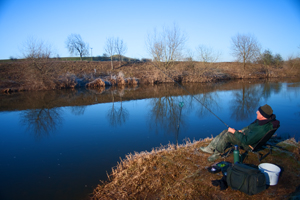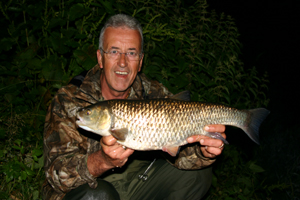 Anyone who is a relative newcomer to fishing and reads the papers avidly will be labouring under the impression that seven pounds chub are pretty common and that sixes are merely run-of the-mill captures. If only that were true.
Anyone who is a relative newcomer to fishing and reads the papers avidly will be labouring under the impression that seven pounds chub are pretty common and that sixes are merely run-of the-mill captures. If only that were true.
The truth is that the headlines are dominated by a relatively small number of fish from the Stour, Ouse and recently the Thames. For the rest of us the reality is very different. Last winter I had a six from the Derbyshire Derwent. Previous to this I had one from the Swale, but these were exceptional specimens. If you live in the Midlands or the North, certainly on the East of the Pennines, four-pounds chub are a creditable target and genuine fives are exceptional fish.
It doesn’t make you a lesser angler if you target fish of this size, you are simply being a realist. Let’s face it, you’ll still have to master exactly the same techniques to land a five-pound chub from the Swale as you will to land a much bigger one from the headline grabbing rivers, so instead of bemoaning your luck, set a sensible target and go for it!
You might even get one of those elusive sixes.
It’s easier to catch a big chub in winter than in summer for two reasons. Physically they pack on weight through the autumn and plummeting temperatures sees a migration of the biggest fish from the shallows to their winter quarters. That sorts out the location.
When seeking big chub in winter you should target the deeper, slow moving swims. If that swim also has snags or cover, so much the better.
My favourite cover is a mature hawthorn bush. The Autumn floods deposit grass and other debris in the branches to provide a dense canopy for chub to shelter beneath. Only blackthorn offers comparable cover.
Because you will be targeting swims that contain perhaps one or two fish be prepared to work hard for a limited number of bites. Mistakes will be punished, a missed bite, a bumped fish, standing on the skyline or even a clumsy footfall can mean no more action that day so make sure you consider at least four swims.
Wasn’t it Isaak Walton who described chub as the ‘fearfullest of fishes’? How right he was.
My tactics for winter chub are certainly not revolutionary. Indeed they are very simple. Providing we’ve not endured a week or more of severe frosts and the river isn’t carrying too much colour I am quite happy to rely on one bait – plain old white bread.
Make sure you buy the good stuff though and it needs to be fresh. I’m a fan of the Warburtons medium sliced white loaf. It costs twice as much as a cheap supermarket loaf but the quality is more important to me. Let’s face it, how often can you go fishing on a bait bill of less than a quid these days?
I take six slices from the loaf for hook bait and the rest goes in the blender, crusts and all. Don’t overdo the liquidising and keep the flakes on the coarse side.
 I start by introducing a couple of walnut sized lumps of the liquidised bread into each swim before tackling up but make sure you can cast to where it hits bottom. Flakes of liquidised bread will drift several feet downstream even in slow moving water, however, the pieces of crust are buoyant and will rise from the feed area before becoming waterlogged and fluttering back down, spreading the attraction over a wider area and drawing fish from downstream.
I start by introducing a couple of walnut sized lumps of the liquidised bread into each swim before tackling up but make sure you can cast to where it hits bottom. Flakes of liquidised bread will drift several feet downstream even in slow moving water, however, the pieces of crust are buoyant and will rise from the feed area before becoming waterlogged and fluttering back down, spreading the attraction over a wider area and drawing fish from downstream.
It will be half an hour before I make my first cast and I will spend no more than thirty minutes in each swim, usually making one cast only. The small cage feeder effectively deposits one more helping of bread in each swim and the rotation between swims means an extra helping is added every two hours. More than enough to tempt a cagey chub.
In later articles I will talk about other chub tactics but my opening gambit is invariably the same, a single piece of bread created with a Drennan Flake Punch. Every angler should own one of these. They are brilliant and you can be confident that you still have a bait on the hook after half an hour.
Bites are normally positive. Ignore the little taps, wait for a positive pull and hold on tight. To give an inch is to invite trouble.
As Del Boy said, “He who dares wins, Rodney!”
Bob’s Tackle
Rods – Daiwa Powermesh PMS2112B with quiver tip section fitted
Reels – Daiwa SSII3000C
Reel Line – Daiwa Infinity Duo – 6lb Test
Hook Link – Daiwa Super Shinobi – 3 to 5lb Test, usually 4lb
Hooks – Size 10 Drennan Super Specialist
Five Tips
1. Don’t rush out of bed, dusk is the key feeding time
2. Step up the hook link and hook size if there are serious snags
3. Try a ‘double’ punch when the fish are feeding well
4. Rest your hand on the rod at all times
5. Ignore sharp knocks on the tip and let the bite develop before striking
Five Big Chub Rivers
1. River Swale, Leeds & District waters, Topcliffe to Asenby
2. River Wensum, Norfolk
3. River Thames, Oxon
4. Upper Great Ouse, Bucks
5. River Stour, Hants
